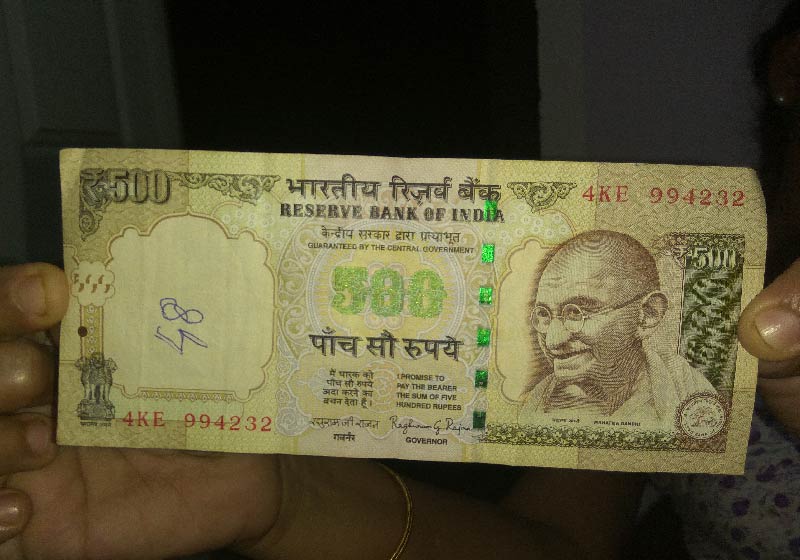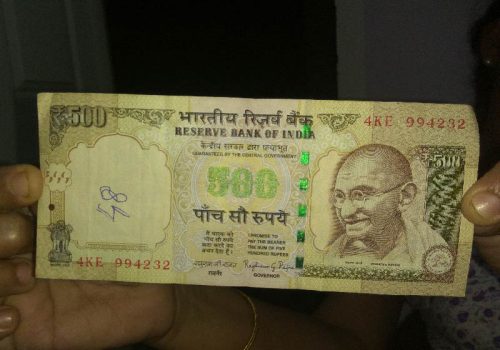The demonetization exercise by the Indian government has many dimensions.
 This corner focuses solely, and makes a plea, a suggestion, and then proposes several pragmatic solutions to reduce the hurt and misery of two classes of people in India, who may be suffering the most, and who are at the extreme bottom of life and living. It does so without concerning itself with the rest of debate and noise around the decision of demonetization.
This corner focuses solely, and makes a plea, a suggestion, and then proposes several pragmatic solutions to reduce the hurt and misery of two classes of people in India, who may be suffering the most, and who are at the extreme bottom of life and living. It does so without concerning itself with the rest of debate and noise around the decision of demonetization.
This corner also leaves the reader with a teaser at the end – intentionally. Please keep aside 10 minutes and read on if interested, or come back later if the topic intrigues you.
Simply said, in this day and age of demonetization of currency notes in India, the people and government of India must bring compassion and help to the two classes of people described below, who may be in real pain, right now. Each day that is wasted is adding cruel grind to the already miserable lives that they live.
The question that spurred this corner is very simple – How and where will the homeless, and those in modern slavery in India, go to convert or deposit in banks, with the few olden rupee notes that they may have? Or, will they, about 20 million at least, slowly flicker away, unknown, every day as of now? In any case they do not matter.
The background to the plea – the homeless in India
A homeless person is said to be someone who cannot afford housing or is unable to maintain a regular and safe shelter. According to a February 2016 report by the India Today magazine, India is home to about 78 million homeless people. Factors that contribute to homelessness are – lack of affordable housing, changes in the industrial economy leading to unemployment, inadequate income support, de-institutionalization of patients with mental health problems, physical or mental illness, disability, substance abuse, domestic abuse or violence, and job loss.
Out of the above 78 million, perhaps many will be able to manage and live with demonetization, go to banks, and exchange or deposit old notes and withdraw newer currency. But let us focus on those who may be at the extreme bottom of this homeless pyramid – the beggars, the homeless that sleep on the roadsides, pavements, beneath the flyovers, in corridors or shades of markets, on railway platforms and bus stations, or maybe daily wage workers who sleep on their hand-carts, or any such arrangements.
The number of such people who are the most destitute in India was 1.77 million according to the last available Census data of 2011. This number may be capturing the reality insufficiently, as often governmental census do, and it may have grown in last 5 years. Whatever the number, it is at least about 2 million in 2016.
Next, it may be logical to assume that some or many of them have tucked away at least Rs 1,000 or 2,000, or maybe even Rs. 10,000 in the inner folds of their tattered clothing as they struggle to live every day on the streets of India. Post-demonetization, apart from being able to obtain any new money either by begging or any method of earning new money, how will these folks survive now – their entire lifeline of 1,000 or 2,000 in their pockets being worthless?
What will these people do in the face of the inability to buy even a slice of bread to survive today or tomorrow by the time you read this corner, or will some of them be departed souls by then?
The background to the plea – those in modern slavery in India
Modern slavery is described as one person possessing or controlling another person in such as a way as to significantly deprive that person of their individual liberty, with the intention of exploiting that person through their use, management, profit, transfer, or disposal.
The 2016 Global Slavery Index of the Walk Free Foundation estimates that there are over 18 million people in India living lives of said modern slavery. The report further adds that India’s challenges are immense – across India all forms of modern slavery, including inter-generational bonded labor, trafficking for sexual exploitation and forced marriage, child labor, and other indescribable forms, exist. Evidence suggests that members of lower castes and tribes, migrant workers and religious minorities are disproportionately affected by modern slavery. Modern slavery occurs in brick kilns, carpet weaving, embroidery and other textile manufacturing, forced prostitution, agriculture, domestic servitude, mining, and organized begging rings, and labor, particularly prevalent throughout India with families enslaved for generations.
Thus the question which this corner now begs – how will these who are actually in physical captivity change or deposit any monies that they may have been able to save away from their “earnings” that their masters or pimps have given them over the past many years? A bonded labor in a brick kiln may have saved a Rs. 100,000/- in cash, in the past 5 years of his back-breaking life. A sex worker, in captivity in the brothels of metro cities may have saved a Rs. 100,000/- in cash, in past 5 years of her ruthless exploitation. And so on. Even those sex workers rescued by the police and NGOs that are housed in shelter homes are not allowed to go out of their institutions. What should they do?
If these 18 million folks cannot even physically get out of their places of slavery and dens of criminalization, how will they open bank accounts, and then deposit their old currency, and then draw new currency? Or, by the time you finish reading this corner, and nothing is done, their “savings” will become paper, and they will be double-killed in this one lifetime?
The suggestion
The government must immediately take steps as suggested below that could at least in some minimal way reduce the pain and double-killing of these two classes of people. If we add up the homeless 1.77 million, and the 18 million in modern slavery – it already adds up to 20 million souls – the number may be much more – but let us stay with 20 million Indians.
This corner lays out a sincere plea, suggestions, and a solution on behalf of both the classes.
Firstly, talking of the homeless. There are already two governmental schemes that are there to ameliorate the sufferings of the homeless – the National Urban Livelihood Mission, and the Scheme for Shelters for Urban Homeless. However, both the Centre and States of India have been woefully lacking in implementing both of these schemes, so much so that on November 11, 2016, the Supreme Court was compelled to observe that “In spite of availability of funds and a clear mechanism through which to disburse them, we see an extremely unsatisfactory state of affairs on the ground. This is despite our continuous monitoring of the matter. Yet another winter approaches and enough has not been done for the protection of many homeless in our towns/cities.”
In any case, and now especially in light of the demons of demonetarization that may be stalking the homeless as discussed above, it is incumbent upon the Centre and State governments of India to take urgent steps on a war-footing to implement the above two schemes – so that some relief may reach the affected ASAP.
Plus, the governmental agencies at the center and state must add temporary patrols late at night and early morning to distribute food to those found sleeping on roadsides, and in all such forms of homeless-ness. Or, maybe even sell food-packets to the homeless in exchange of old currency during these patrol rounds.
More of this is in the PPP solution that this corner proposes. How to accelerate and achieve at least some of the above goals so that the hurt of demonetization is lessened on this unfortunate class of people, is laid out in the next section.
Secondly, talking of souls that are trapped in modern slavery, and imprisoned. There is already a policy decision by the government of India to set-up Anti-Human Trafficking Police Units (AHTPU) in all 650 districts of India. However what we have so far are only 215 such units, according to latest reports.
To bring a ray of hope in the lives of these 18 million Indians living in servitude and modern slavery, these 215 AHTPU must be instructed to immediately launch a special drive to weed out the nodes and dens where people are held in captivity and against their will. In parallel, all state governments and the center must together set up temporary AHTPU in the remaining 435 districts of India to go after and smoke out as many still living lives from these dens of the netherworld.
Let this demonetization exercise be a small blessing in disguise for these enslaved souls to help them achieve liberty – and to open their bank accounts, and exchange what little old money they may have stashed away in lieu of all their pain and misfortune that life has dealt them so far.
The PPP solution
This corner advocates that both of the above suggestions must be carried out by the central and state agencies immediately – and must be implemented with alacrity to bring effective succor to millions of lives. In its attempt to provide a solution, rather than just add to the noisy rhetoric regarding demonetization, this corner has also designed a simple PPP solution to musculate the suggestions that it has put forth above.
Therefore, in addition to the recommendation of above steps by the central and state governments, this corner also makes an offer of a PPP (public-private-partnership) that can bring a sum of over Rs. 20,000 crores (US$ 3 billion) from civic society, that can be contributed directly, in new cash, to the capacity building, expansion, and delivery of the governmental efforts towards the National Urban Livelihood Mission, and the Scheme for Shelters for Urban Homeless (for the homeless class); and Anti-Human Trafficking Police Units (for the enslaved class).
However, this corner would like to see what the government of India is doing, and the responsiveness of you, the reader, and the leadership of India before proposing the PPP solution that we have designed. The people and governments of India – central and state – must show awareness, compassion, and a will to act on the issue raised above. It is no fun when the sheep talk in a thunderstorm – goes a New Zealander saying. What it means is that there is no joy in talking when there is so much rain and noise that nobody listens to you.
I have never felt as submerged in the pain of my writing in my life, as I do today. There are 20 million plus Indians who are totally on the brink of dying – and you, me, the government can together do something to prevent this. Or do nothing, and just flick it away as a remote nuisance. Or think of it as “collateral damage” towards a journey.
Those in leadership positions in government, bureaucracy, and police in India must display and deliver compassion towards the most unfortunate in our society and must realize that there are some sections of India who may be dying a slow death during this process of demonetization. We must respect the human value of each life – and not insulate our conscience to what is happening around us merely because we can use vocabulary that sanitizes reality.
We may be happy or angry and energetic to discuss and argue among friends, family, and in the public sphere about any wars or events that have an impact on real lives – as long as it is not interfering in the cocoon of our lives, and as long as all of this nuisance of pain and misery in some far-away zone is dis-intermediated from our reality. And as long as we use words in conversations, or rather in our conversations with our own selves, that are not uncomfortable, and do not impinge upon the raw-ness of what really could be happening.
We use soft and camouflaged words and language in our debates without sensitivity to what those words may mean – and we do it because either we are too invested in our own views and we neglect any other reality, or, because we may be too lazy to even contemplate what that horrific reality could mean if we think a bit deeper on that particular issue, and perhaps because sub-consciously we do not even wish to know about the painful reality – since it is too far away from us, and also since it could jar our own world-view if we look it in the eye.
We are too lazy, too invested in our own narcissism, too comfortable in our shells, too busy to think about some remote outliers, and too busy and proud of ourselves to think about something away from our intellectual and physical zones.
These 20 million plus people of India are humans – like you and me – who may be dying of starvation, right this very minute as you finish reading this article. Forget the government of India, it is the people of India who must think.
If you have read thus far, thank you. My only intent of writing this corner today is that I want to ask you to think. India is a nation of 1.3 or so billion people. We all think about the poorest of the poor. Well, above I have given you a description of two of the classes who are most marginalized. They number about 20 million or much more. And they may have no light at the end of any tunnel.
Over to you, the leaders, and people of India. And, the PPP solution in next.
(Robinder Sachdev is the President of Imagindia Institute, an independent think tank and research center with a mission to promote the image and imagination of India.)




3 Comments
This supposed ANTI_SLAVERY campaign by the West is actually an attempt to cloud the REAL picture. The Christian and Muslim world are the root cause of historical slavery and the only groups to religiously justify it. Thus, the West now wishes to paint itself in glory for a non-problem, while quietly shoving their historical misdeeds under the rug. India has bonded-labor, which is no doubt undesirable. However, the campaign to end this needs to be labor reforms and credit expansions. Sexual exploitation is due AGAIN wholly to the West. Take a guess which jeebus-worshippers actually go to Thailand and have sex with little girls. However, to add to the misery the Christian Missionary then comes to Thailand and says I have the solution for your sex slavery issue, an issue created by Christian perverts in the first place.
OK – Let’s get this straight: This ‘demonetization’ scheme was NOT – I repeat NOT intended to curb corruption: It was REALLY implemented for three things to occur:
a) To win the elections in UP – Modi wants his party to win the elections in UP. By controlling the flow of money, he has now made both 1,000 and 500 rupee notes obsolete – this will ensure that his political rivals won’t have enough funds to bribe the winners in the election to join their party afterwards. Since his party controls the flow of cash only Modi’s party will have enough money to bribe election winner to join the BJP (Modi’s party) – UP has massive farmlands and Modi’s foreign financial backers want to grow GMOs on said land.
b) Many of the foreign Banks operating in India had a direct hand in funding Modi and his election campaign – Modi’s donors also use these Banks to launder their cash – and to take out loans. It’s no secret that a lot of Banks in India are facing a cash crunch because of bad loans – this ‘demonetization’ scheme has resulted in over 11,000 new bank accounts and instant liquidity for the banks – many of whom needed bail outs to keep on functioning – this scheme has been a boon to them!
c) This is yet another move towards a cashless society – there actually is a village in Modi’s home town of Gujrat that was adopted by a foreign bank – the locals use card only for transactions, never cash – this is just a move to force locals to use new services that allow for cashless transactions. Mukesh Ambani (who is a Modi ally) has started a new cashless service called Jio recently – I don’t think it’s a coincidence that Modi has made this move now since many business people will be forced to use such services in the future to avoid similar scenarios – only the poor and the truly honest will suffer.
Why Narendra Modi’s Demonetization measure violates RBI Act and creates financial anarchy http://seemasapra.blogspot.in/2016/11/why-narendra-modis-demonetization-law.html